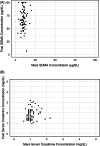Symmetric dimethylarginine concentrations in healthy neonatal foals and mares
- PMID: 34738665
- PMCID: PMC8692187
- DOI: 10.1111/jvim.16295
Symmetric dimethylarginine concentrations in healthy neonatal foals and mares
Abstract
Background: Symmetric dimethylarginine (SDMA) is a renal biomarker correlated with glomerular filtration rate (GFR).
Objectives: Describe changes in SDMA in clinically healthy foals and their mares during the first month postfoaling.
Animals: Convenience sampling of healthy periparturient Thoroughbred mares and their full-term foals from a population of client-owned horses.
Methods: Serum and EDTA whole blood samples were collected from mares in their last month of pregnancy and then from mares and foals at approximately <12 hours, 48 hours, 7 days, and 30 days postbirth. Samples were processed at a commercial reference laboratory for CBC and serum biochemistry, including SDMA concentrations.
Results: A total of 125 foals and 104 mares were included. Upper limits for SDMA concentrations in foals were above the adult horse reference interval for the first 20 or more days of life. Median SDMA concentrations decreased from 70 μg/dL (range, 7-100 μg/dL) to 18 μg/dL (range, 6-27 μg/dL) during the first 3 to 4 weeks of life. At birth, the SDMA concentration reference range was established as 0 to 100 μg/dL (upper limit of the assay); 0 to 85 μg/dL for 1 to 4 days old, 0 to 36 μg/dL for 5 to 10 days old, and 0 to 24 μg/dL for 20 to 30 days old. The upper reference limits for SDMA concentrations in mares did not differ from the general reference interval for adult horses. No correlation was identified between mare and foal SDMA concentrations (ρ = .06, P = .58).
Conclusions and clinical importance: Foal SDMA concentrations remained higher than the upper limit of the adult reference range and foals require a different reference range dependent on age.
Keywords: horse; kidney; neonate; renal.
© 2021 The Authors. Journal of Veterinary Internal Medicine published by Wiley Periodicals LLC on behalf of American College of Veterinary Internal Medicine.
Conflict of interest statement
Rebecca Mack, Michael Coyne, Rachel Murphy, Evan Hegarty have an affiliation with the commercial funders of this research as current employees of IDEXX Laboratories, Inc (
Figures



References
-
- Kakimoto Y, Akazawa S. Isolation and identification of N‐G,N‐G‐ and N‐G,N′‐G‐dimethyl‐arginine, N‐epsilon‐mono‐, di‐, and trimethyllysine, and glucosylgalactosyl‐ and galactosyl‐delta‐hydroxylysine from human urine. J Biol Chem. 1970;245(21):5751‐5758. - PubMed
-
- Fleck C, Schweitzer F, Karge E, Busch M, Stein G. Serum concentrations of asymmetric (ADMA) and symmetric (SDMA) dimethylarginine in patients with chronic kidney diseases. Clin Chim Acta. 2003;336(1–2):1‐12. - PubMed
-
- Kielstein JT, Salpeter SR, Bode‐Boeger SM, Cooke JP, Fliser D. Symmetric dimethylarginine (SDMA) as endogenous marker of renal function—a meta‐analysis. Nephrol Dial Transplant. 2006;21(9):2446‐2451. - PubMed

